Related Statutes: The National Environmental Policy Act and Section 4(f) of the Department of Transportation Act
OBJECTIVES
This portion of the tutorial provides information on the relationship of Section 106 with the National Environmental Policy Act (NEPA) and Section 4(f) of the Department of Transportation Act. It also discusses ways of effectively coordinating Section 106 with NEPA and Section 4(f). When you have finished, you should have a basic understanding of the following:
- How Section 106 decision-making supports NEPA and Section 4(f) compliance
- Why there is a need to coordinate Section 106 with NEPA and Section 4(f) for effective FHWA project delivery
OVERVIEW
One of the activities associated with the initiation of the Section 106 process is to coordinate Section 106 with other statutory reviews. Though NEPA and Section 4(f) have requirements independent from Section 106, compliance with NEPA and Section 4(f) relies on the decisions and findings made in the Section 106 process.
The Section 106 process is essential to identifying those historic properties that must be considered under both NEPA and Section 4(f). An effective approach to coordinating Section 106 compliance with NEPA and Section 4(f) is to develop a plan early in project development or in the project planning phase—that is, during project initiation or NEPA scoping. This plan serves as a roadmap for integrating Section 106 consultation with the steps in a NEPA review and Section 4(f) evaluation. Implementing Section 106 steps too late will result in project delays, and possibly the need to revisit or redo aspects of a NEPA review or Section 4(f) evaluation.
SECTION 106 and NEPA
It is FHWA policy to manage the NEPA review and decision-making process as an “umbrella” under which applicable laws, executive orders, and regulations, including Section 106, are considered and addressed prior to final FHWA approval of a project. This process allows the FHWA Division Offices (DOs), State Departments of Transportation (DOTs), and Local Public Agencies (LPAs), whose transportation projects rely on FHWA funding or approvals, to make final project decisions that balance engineering and transportation needs with social, economic, natural resource, and historic preservation (i.e., Section 106) factors.
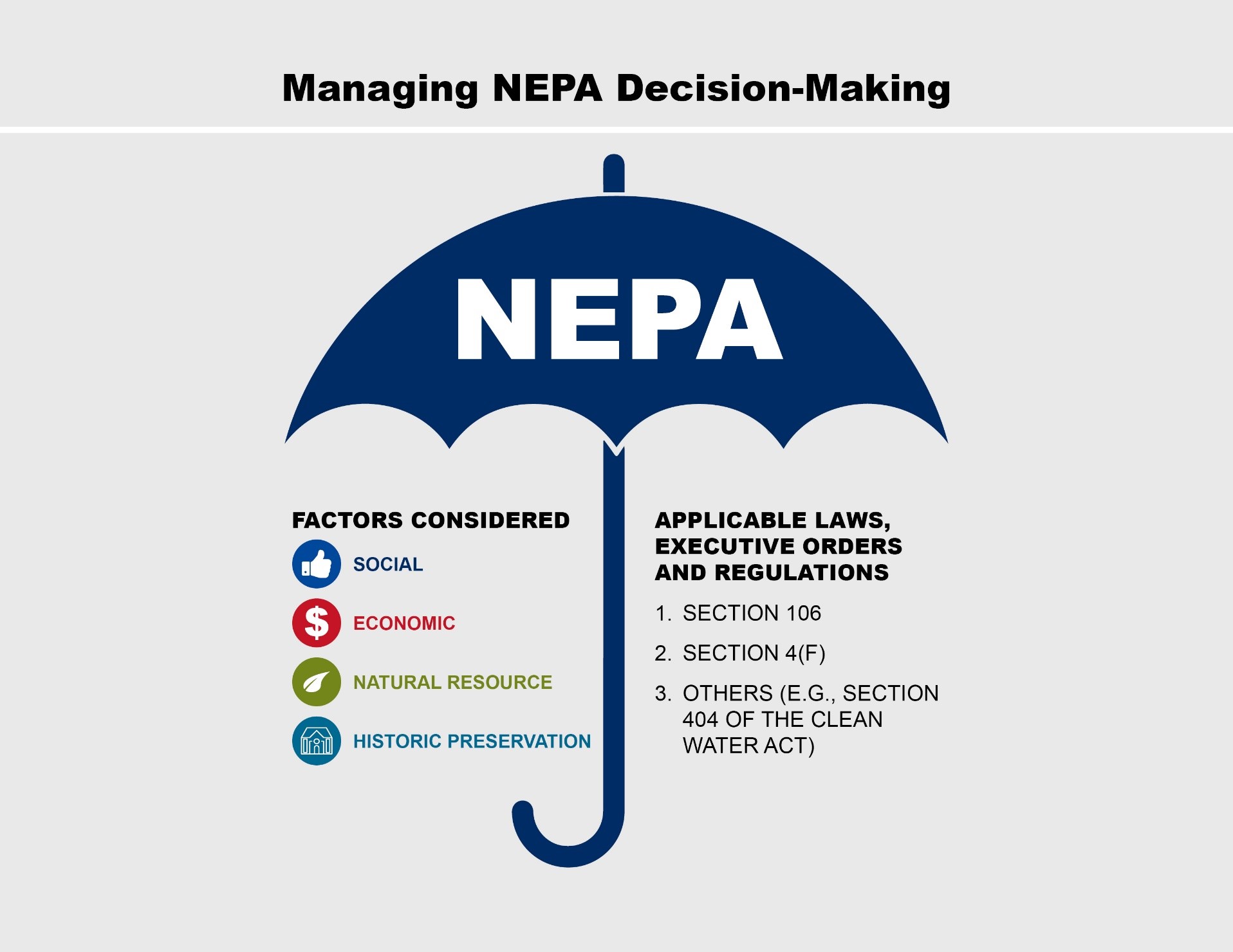
The NEPA “umbrella” showing factors considered and applicable laws, executive orders, and regulations in the NEPA process. Source: FHWA.
In the context of NEPA compliance, the majority of FHWA projects are processed as Categorical Exclusions (CE). CEs are actions that do not require the preparation of an Environmental Assessment (EA) or Environmental Impact Statement (EIS). Even though a project is categorically excluded from the preparation of an EA or EIS, the CE project must still meet the requirements of Section 106.
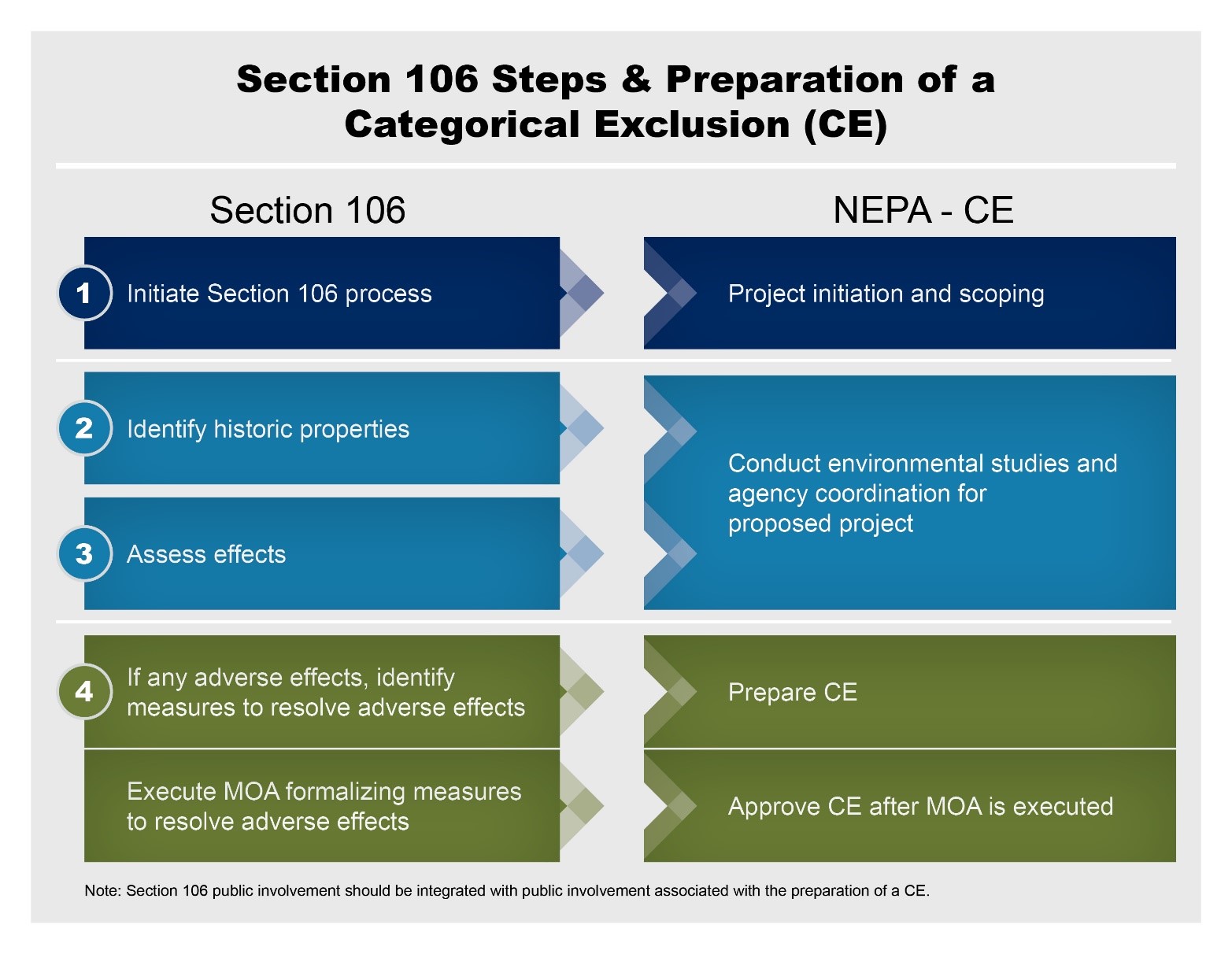
This graphic portrays the relationship of Section 106 and a CE. See full description here.
FHWA processes more projects through an EA than through an EIS. EAs are used to determine if a project will have significant impacts on the environment. An EIS is reserved for large complex projects with significant impacts.
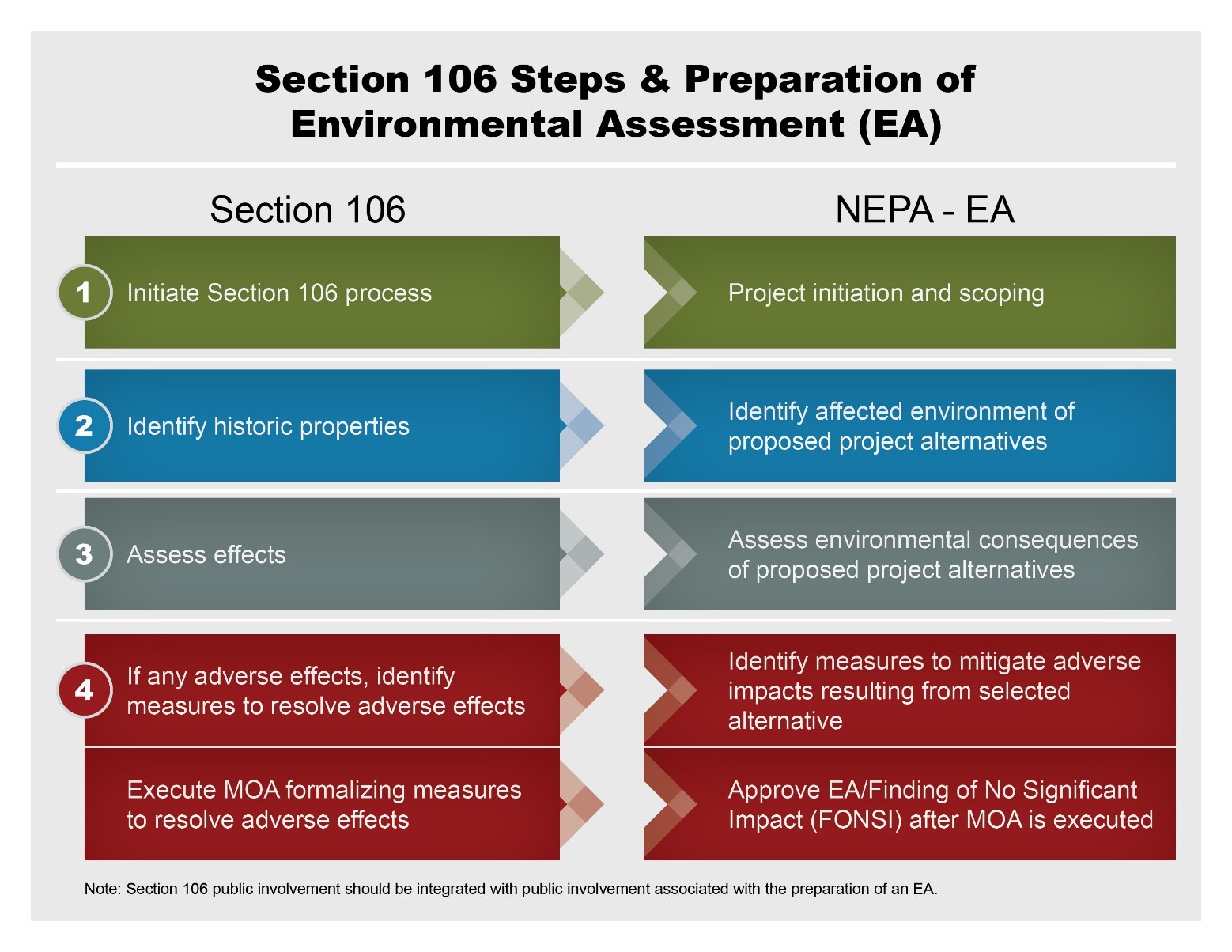
This graphic portrays the relationship of Section 106 and an EA. See full description here.
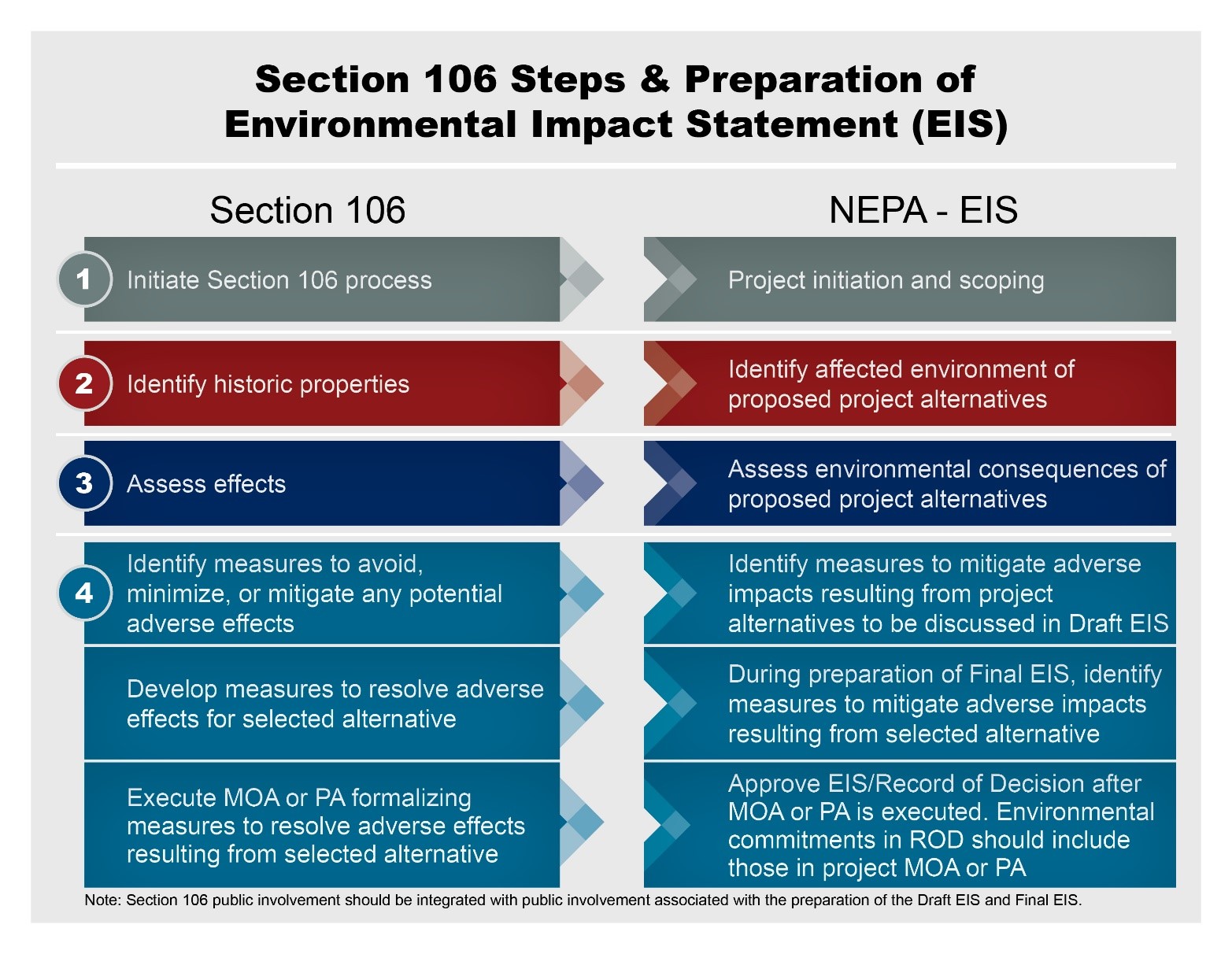
This graphic portrays the relationship of Section 106 and an EIS. See full description here.
Historic properties identified during the identifying historic properties step of the Section 106 review process (Step 2) meet the definition of historic and cultural resources that must be considered as part of the affected environment under NEPA. Therefore, the identification step of Section 106 should be addressed, and assessing if a project will have an adverse effect on historic properties (Step 3) needs to be defined, prior to the NEPA analysis of the proposed project’s affected environment and resulting environmental consequences. It is not always the case, but impacts to historic properties may be a deciding factor in evaluating alternatives under NEPA.
The Section 106 process must be completed prior to the approval of a CE, or an EA/Finding of No Significant Impact (FONSI) or a Final EIS/Record of Decision (ROD).
Further resources on the integrating Section 106 and NEPA:
- Integrating NEPA and Section 106 webpage by the ACHP
- NEPA and NHPA: A Handbook for Integrating NEPA and Section 106 by the Council on Environmental Quality, Executive Office Of The President, and ACHP
- General Rules for NEPA-Section 106 Coordination by the National Preservation Institute
SECTION 106 AND SECTION 4(f)
Another one of the applicable laws under the NEPA “umbrella” is Section 4(f) of the Department of Transportation Act. Section 4(f) requires U.S. DOT agencies, including FHWA, to consider park and recreation lands, wildlife and waterfowl refuges, and historic sites during project development. A “historic site” as defined in FHWA’s Section 4(f) regulations is a property listed in or eligible for listing in the National Register (i.e., a historic property under Section 106). As with NEPA, Section 106 identification should be completed and any issues regarding eligibility and effects resolved prior to the completion of a Section 4(f) evaluation.
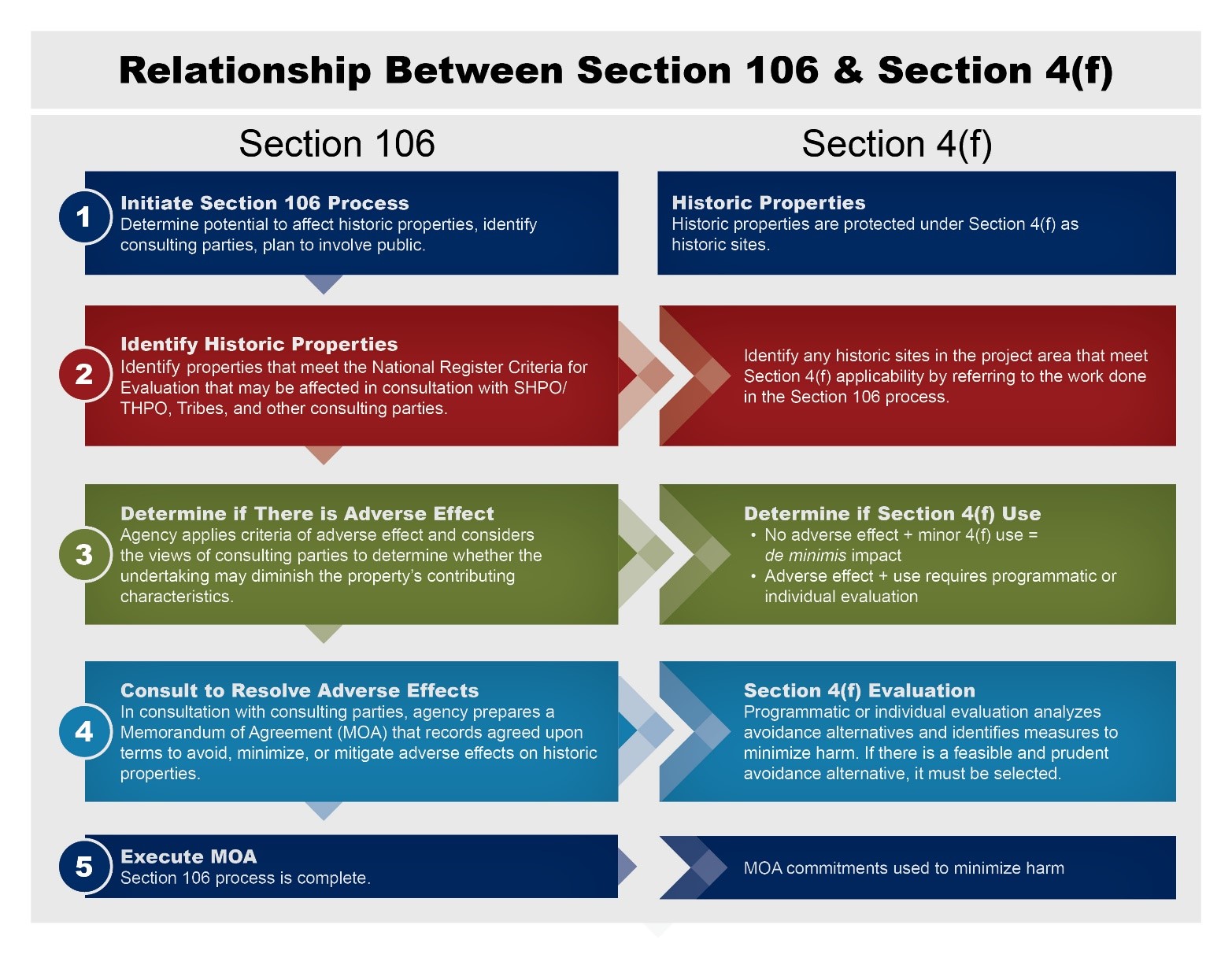
This chart portrays the relationship between the steps in Section 106 process and Section 4(f). See full description here.
Before approving a project that uses a historic site (or any of the other properties protected under Section 4(f)), FHWA must determine the following:
- That there is no feasible and prudent alternative that avoids the use of a historic site and that the project includes all possible planning to minimize harm to the historic site; or
- FHWA can make a finding that the project has a de minimis impact on the historic site.
To make a de minimis impact finding, FHWA must demonstrate that a project will have No Adverse Effect on the historic site, using the Section 106 process. See FHWA’s Section 4(f) tutorial for the definitions of “use,” “feasible and prudent alternative,” “minimize harm,” and “de minimis.” If there is a use greater than de minimis, measures to minimize harm required under Section 4(f) are usually identified through the Section 106 process and are incorporated into the Section 106 Memorandum of Agreement (or Programmatic Agreement) resolving adverse effects on historic properties.
As with the NEPA review process, Section 106 needs to be completed in order to complete a Section 4(f) evaluation.
For questions or feedback on this subject matter content, please contact David Clarke.

